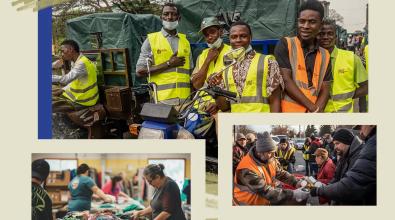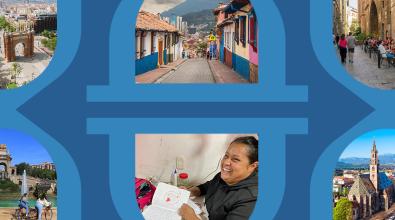Putting residents’ wellbeing first in a city built from scratch

Several years ago, Santa Monica, California, won the Bloomberg Philanthropies Mayors Challenge with a breakthrough idea for how to measure progress as a city. Instead of using traditional benchmarks like per-capita income or GDP growth, which focus on economic attainment, Santa Monica developed a Wellbeing Index. It’s a more holistic measure, incorporating aspects like sense of community, mental and physical health, and opportunities to learn. The city is now budgeting projects based on the impact they have on wellbeing.
As an urban planner who has worked in India for 15 years, I was curious: Could Santa Monica’s idea work in Indian cities? India is urbanizing at a staggering pace: By 2050, about 20 percent of the world’s population will be living in a city in India. I wanted to find out if a tool created in a seaside city in Southern California could be adapted to suit a very different cultural and political context. If so, the impact could be huge.
My research led me to Amaravati, a city that today exists primarily on paper. Planned as the sparkling new capital of the state of Andhra Pradesh in southeast India, Amaravati is expected to grow, in just 20 years, from a farming region of 300,000 people into a bustling metropolis of 3.5 million. Befitting the project’s ambition, N Chandrababu Naidu, the state’s Chief Minister and driving force behind the new city, has boldly announced that Amaravati is to become one of the world’s “happiest cities.”
Mr. Naidu sees the happiness agenda in Amaravati as a way to keep government focused on the things that matter most to constituents. He also thinks it will help distinguish the new city from other fast-growing urban centers in India and attract global investment and talent. Research shows that happier citizens are healthier, more collaborative, and more productive. As a “greenfield” city, Amaravati offers a blank canvas to measure, monitor and improve happiness from the start.
To advise the Amaravati effort, I reviewed case studies from other cities and countries, and interviewed more than 20 global and local experts. Here are five things I found that may be useful not just to Amaravati but to any city thinking about aligning its work around the goal of improving happiness or wellbeing:
- There are a growing number of global examples to draw on. Along with Santa Monica, cities such as Bristol in the U.K., Seattle in the U.S., Vancouver in Canada, and Victoria in Australia, have developed their own metrics. The U.K. and South Korea have developed national indicators, and the OECD has developed a framework for measuring wellbeing in 38 industrialized nations. Closer to India, Bhutan pioneered the global happiness agenda almost 50 years ago when it began measuring “Gross National Happiness.”
- The relationship between money and happiness is complicated. Research by the British economist Lord Richard Layard shows that as countries get richer, they don’t necessarily get happier. In the U.S. and U.K., he found, GDP tripled from 1950 to 2010 but life satisfaction stayed the same. However, research also shows happiness gains as countries rise out of poverty, at least until their per-capita purchasing power reaches about $15,000 per year — roughly enough to meet basic needs like food and shelter.
- But there are some universal truths. Research points to common themes across cultures about what makes us happy: strong social connections, opportunities for learning, good mental and physical health, meaningful work, equality, and charity are some of them. Still, local variations are important. Bhutan’s Happiness Index puts an emphasis on spiritual wellbeing and even ecology: It considers the wellbeing of all living creatures, including forests, rivers, and animals.
- Big data gaps exist. My interviews with local officials in Amaravati found no robust local data on mental illness to draw on. That’s just one example of the kinds of data sources local authorities need to build. Another is citizen surveys: Individual happiness is measured by asking people directly about how happy they feel. This data on self-reported happiness is largely absent in countries like India.
- Process matters. Every city that has developed a wellbeing or happiness index has wrestled with similar questions. How are we defining happiness — and who gets to decide? What metrics will be used to measure it? How will those metrics be weighted? How will the data be collected? And most important, how will the data be used to inform policy? Community participation within this process is vital, as the bulk of the data collected is self-reported. In fact, one of the big learnings from Santa Monica is to involve the community early in the process of developing the Wellbeing Index.
Implications in India and beyond
For Indian cities, developing happiness metrics means wrestling with a lot of contradictions. For example, one in six Indian urban dwellers currently lives in a slum where poverty, pollution, and access to drinking water, sanitation, housing, education and healthcare are major problems. Yet the same communities, with families living in close proximity, often demonstrate levels of social cohesion that would be the envy of the West.
At the same time, Indian cities are home to a fast-growing middle class. Even as their basic needs are increasingly met, prevalence of family breakdown, alienation, stress, and depression are on the rise: A recent report in The Lancet estimated mental illness will impact 20 percent of India’s people by 2020, up from 6.5 percent in 2013. And extreme income inequality, which research shows to be a driver of unhappiness, is an enormous challenge in India, where 1 percent of the people own 82 percent of the wealth.
[Read: How a public-private partnership boosted wellbeing in Santa Monica]
Cultural factors also come into play in Indian cities. Ancient faiths have long suggested that happiness comes from inner peace and not from material wealth or fame. Yet religion can be a source of communal violence in India, and discrimination based on religion, caste, and sexual preferences remains common. Women still face widespread harassment and pressures at both work and home; a 2011 Nielsen survey found India’s working women to be the most stressed in the world. Still, there’s evidence that Indians are able to shrug off a lot of this negativity: A 2015 market study by LG, the home appliance company, found that when asked to consider their own happiness, Indians tend to tune out external circumstances beyond their control.
As a brand new city, Amaravati is poised to take a fresh look at all of these realities and lead a new approach for measuring urban progress. The commitment of the local government and the state chief minister towards making Amaravati a happy city is a great starting point.
While plans for the new city take shape, my research points to several clear takeaways.
First, Amaravati must focus on creating enough jobs so that all of its citizens can meet a basic standard of living. Per-capita purchasing power in India today remains well below the $15,000 threshold where basic needs are met. Apart from income, jobs lead to social connectivity and a sense of purpose, both promoters of wellbeing.
Second, Amaravati must emphasize equality. Deep inequities due to caste, gender, and income lead to unhappiness on individual and social levels. In Finland, the world’s happiest country, according to one prominent analysis, income equality and trust in government are key contributors to happiness.
Third, Amaravati’s physical infrastructure must be built with its happiness goals in mind. The common obsession with gleaming skyscrapers and multi-laned roads filled with cars as a symbol of progress must be questioned. As Charles Montgomery wrote in the book “Happy City,” shorter commutes, walkability, mid-rise housing around public squares, and regular exposure to nature promote wellbeing.
Finally, collecting robust wellbeing data is important. Measuring how happy people are is one part of the challenge, but analyzing the results and investing in solutions that actually improve happiness are crucial next steps.
As Amaravati hones its approach, the city is committed to sharing what it learns with the rest of the world. In April, 2018, the city hosted a global Happy Cities Summit, attended by 1,500 delegates from more than 15 countries, including Santa Monica’s Julie Rusk, who presented the city’s Wellbeing Index. The summit intends to become a global platform for happiness research, with the next edition slated for February, 2019. These summits are designed not only to track Amaravati’s progress in pursuit of happiness but to become the hub for a global movement among cities, to measure what matters.
Rewati Prabhu is the Executive Director Cities at Pell Frischmann, a multi-disciplinary design consultancy based in London with a strong presence in India. Her research in global happiness metrics for cities began at the London School of Economics, where she recently completed an MSc in Cities. She continues to advise the Capital City of Amaravati in their mission to become one of the world’s happiest cities.




